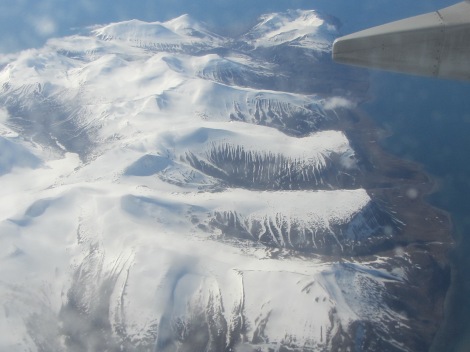
The bow was the favored location for the hardy but many of us watched from the comfort of the lounge.
Life aboard ship was very comfortable. Even with 24 hour daylight there was almost always lots of action, birds flying by or on the water, walrus, polar bears, the occasional seal and whales. My most exciting whale sighting was a Bowhead whale, an arctic species I have never seen before. I didn’t get a picture of any of the whales but I was able to see the unique Bowhead mouth shape in a friend’s picture.

We passed large icebergs when we were in the bay where the Monaco Glaciers were calving.


These photos show the bird cliffs at Alkefjellet. We had hoped for zodiac rides to get closer but the sea was too rough (hence the blurry photo) and we had to settle for views from the ship. It was impossible to count them but we were told there were over 100,000 birds nesting there, mostly Brunnich’s Guillemots (a/k/a Thick-billed Murres). There were many opportunistic Glaucous Gulls hoping to find unattended eggs.

Among the Polar Bears we saw were this threesome: mother, yearling cub and a male in pursuit. She seemed to just want to get away with her cub but he followed them for quite a distance before she finally eluded him. We saw Ivory Gulls where the bears had made a kill, six or seven at a time. It was a thrill to see these elegant pure white gulls.

This is as far north as our journey took us, according to the dashboard in the ship’s library.

I’m looking due north at the beginnings of the ice surrounding the North Pole. We turned around shortly after this picture was taken. The ice would get thicker and finally we would not be able to go further. We traveled 1031 nautical miles. (photo Frank Mantlik) For a detailed description of our trip check out the TRIP LOG.
















